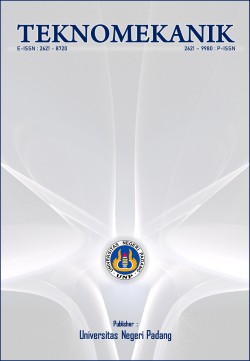Analysis of production and potential utilization as electricity methane gas air dingin landfill
DOI:
https://doi.org/10.24036/jptk.v6i1.31823Keywords:
Methane Gas, Electricity, Air Dingin Landfill, Padang CityAbstract
This study intends to analyze methane gas emissions resulting in landfill procedures. The magnitude of the impact of methane gas emissions on global warming from the waste sector, it is necessary to calculate the potential amount of methane gas emissions of Padang city waste in the Air Dingin Landfill so that it can be used for new energy potential as an alternative energy to replace fossil fuels no longer as a contributor to global warming. In this study, the methodology contains systematic steps in researching to achieve research objectives, namely conducting preliminary studies and literature studies, formulating problems, and setting research objectives as well as how to collect and obtain research data. The result of this study is that the Air DIngin Landfill in Padang City is still processing open dumping, with land that has been operated around 50% of the existing land area. The high operational costs are one of the reasons the sanitary landfill system cannot be done by the Padang City Government. Methane gas produced from 2020 - 2031 in the Air Dingin Landfill is produced from scenario 1 (waste directly landfilled) which is 43,289 gigagrams of CH4 or 43,289 tons of CH4 emissions. CH4 emission scenario 2 (waste reduction by waste pickers in landfill) produced 43,267 gigagrams or 43,267 tons of CH4. CH4 emission scenario 3 (Reduction of waste at source, in the region, and in landfill) produced 40,944 gigagrams CH 4 or 40,944 tons of CH4. After converting methane gas into electrical energy, the potential electricity in scenario 1 is 84.15 megawatts, scenario 2 is 84.10 megawatts and scenario 3 is 79.59 megawatts in 2031.
Downloads
References
Environmental Protection Agency. (2013). Global Mitigation of Non-CO2 Greenhouse Gases: 2010-2030.
European Environment Agency. (2014). Annual European Union greenhouse gas inventory 1990–2012 and inventory report 2014.
Gell, K., van Groenigen, J. W., & Cayuela, M. L. (2011). Residues of bioenergy production chains as soil amendments: Immediate and temporal phytotoxicity. Journal of Hazardous Materials, 186(2–3). https://doi.org/10.1016/j.jhazmat.2010.12.105
IPCC. (2006). Guidelines for National Greenhouse Gas Inventories, Prepared by the National Greenhouse Gas Inventories Programme (H. S. Eggleston, L. Buendia, K. Miwa, T. Ngara, & K. Tanabe, Eds.). IGES.
Material Measurement Laboratory | NIST. (n.d.). Retrieved December 05, 2022, from https://www.nist.gov/mml
Pant, A., & Rai, J. P. N. (2021). Application of Biochar on methane production through organic solid waste and ammonia inhibition. Environmental Challenges, 5, 100262. https://doi.org/10.1016/j.envc.2021.100262
Purwanta, W. (2016). Penghitungan emisi gas rumah kaca (GRK) dari sektor sampah perkotaan di Indonesia. Jurnal Teknologi Lingkungan, 10(1), 1. https://doi.org/10.29122/jtl.v10i1.1497
Scheutz, C., Samuelsson, J., Fredenslund, A. M., & Kjeldsen, P. (2011). Quantification of multiple methane emission sources at landfills using a double tracer technique. Waste Management, 31(5), 1009–1017. https://doi.org/10.1016/j.wasman.2011.01.015
Sriharti, S., Andrianto, M., & Fahriansyah, F. (2018). Production of Biogas from Organic Waste and its Utilization as an Alternative Energy Source. International Journal of Environment, Agriculture and Biotechnology, 3(3), 763–769. https://doi.org/10.22161/ijeab/3.3.7
Downloads
Published
How to Cite
Issue
Section
License
Copyright (c) 2023 Dedy Aulya Pratama, Slamet Raharjo, Rizki Aziz

This work is licensed under a Creative Commons Attribution 4.0 International License.





